[First time visitor? Coming here directly? Stop and learn about the Beyond Hartford, Beyond Cars series before reading on]
Kicking off the 2024 season of #BeyondHartfordBeyondCars with a trip to New Britain, which hadn’t occurred to me to include before because it felt too easy. Frequency on the Hartford-to-New Britain Busway is such that unless it’s a Sunday, I never bother looking at a timetable. I have a short walk to the Sigourney Street CTfastrak Station, then 21 minutes on a bus, and then I’m there, in downtown New Britain.
The pay off is immediate. The Downtown New Britain station is futuristic-looking and easily sets the standard for how all other major bus stops in Connecticut should be: ample seating, wayfinding and schedule signs, shelter from rain, heated waiting area, and again, it just looks cool.
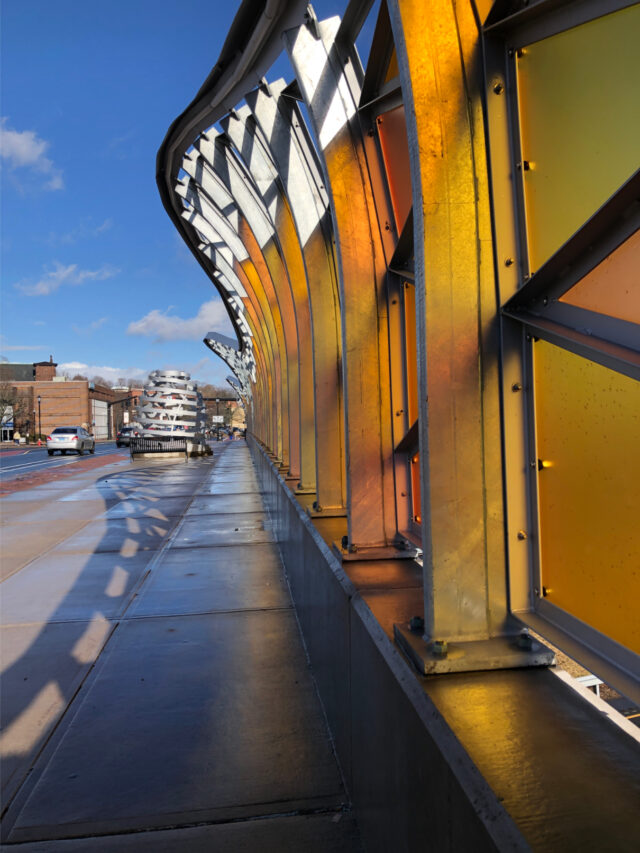
As you exit the bus station, you have a choice.
If you turn right and cross the Beehive Bridge, you go to Little Poland which is where you’ll find Roly Poly Bakery, Staropolska, Euro Plate, and more.
If you turn left, you visit downtown New Britain.
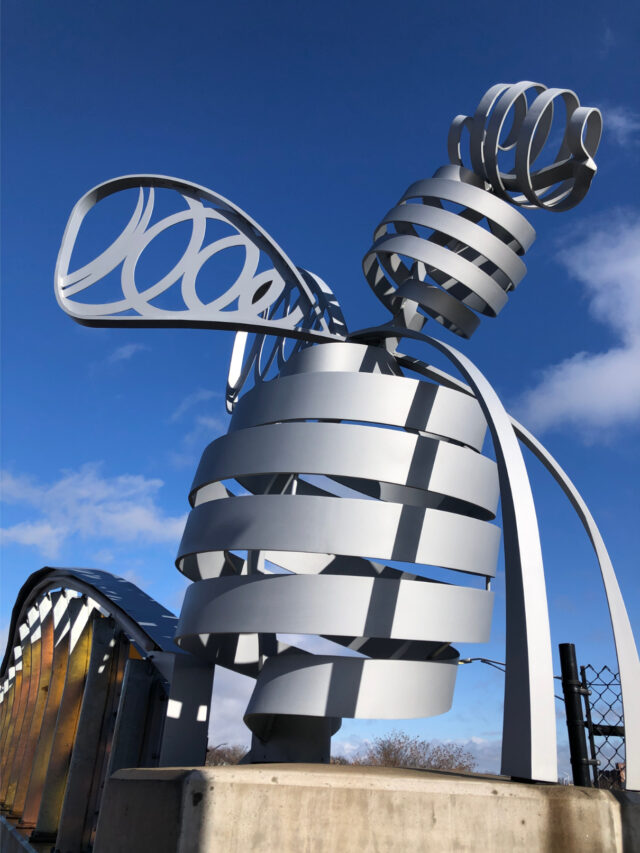
I continue to be surprised at how much New Britain has changed for the better. This is a place where when I lived there, I never managed to find the art museum because of how poor wayfinding was during that era, combined with how most people were not roaming around with smartphones yet. The building was also undergoing a renovation, which probably made it less museum-looking during construction.
New Britain’s not changed so much, however, that it’s unrecognizable. The day it loses its signature grittiness, I will get on an actual phone and give an earful to Mayor Erin, who I assume will remain in office for the next 30 years since her leadership seems to be . . . leadership.
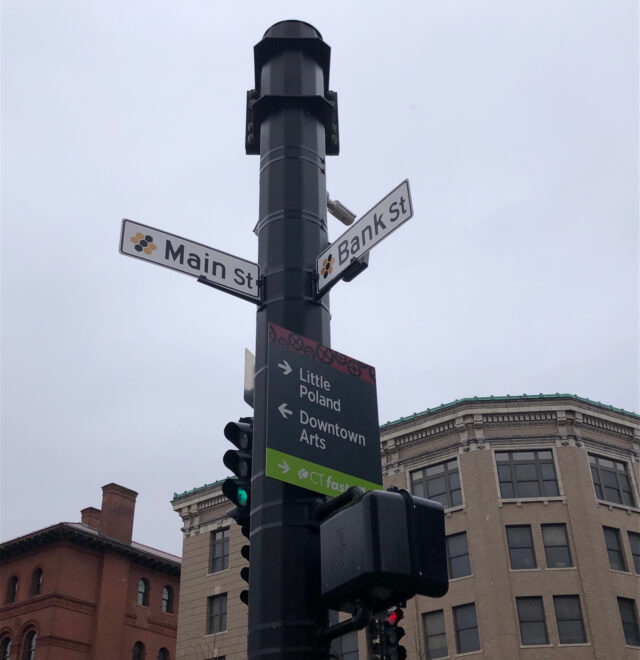
I mean, I can find the damn art museum now, which is pretty much New Britain’s major attraction.
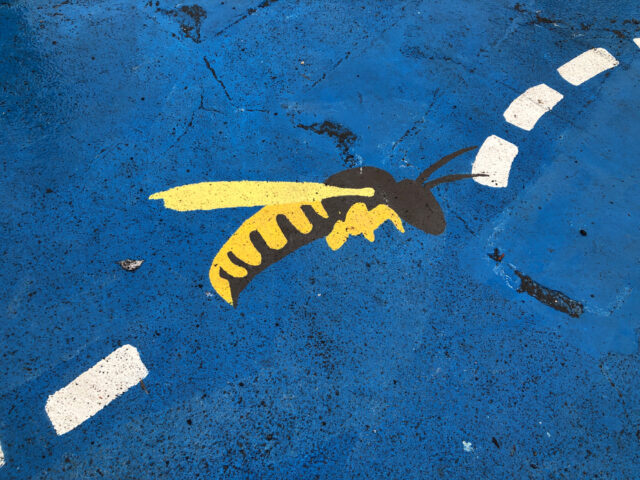
While not nearly perfect, New Britain has earned its reputation in recent years for Complete Streets improvements, beyond just what’s at and immediately around the CTfastrak stations. What this means is that you can walk or bike more safely, comfortably, and conveniently than ever in most parts of town, making it possible to enjoy what is there without a car. For instance, the Beehive Bridge might seem indulgent to those who only move around in cars, but the renovated connection between downtown and that neighborhood helps to reduce the visual and psychic gulf created by Route 72; the bridge’s benches and artwork becomes an invitation for people.
They’ve begun to meaningfully de-center the automobile, which nearby municipalities with far more money have not managed to do. Their local (non CTfastrak) bus system, while a bit wonky, has recently expanded service — something that caught the eye of transportation advocates from outside of Connecticut.
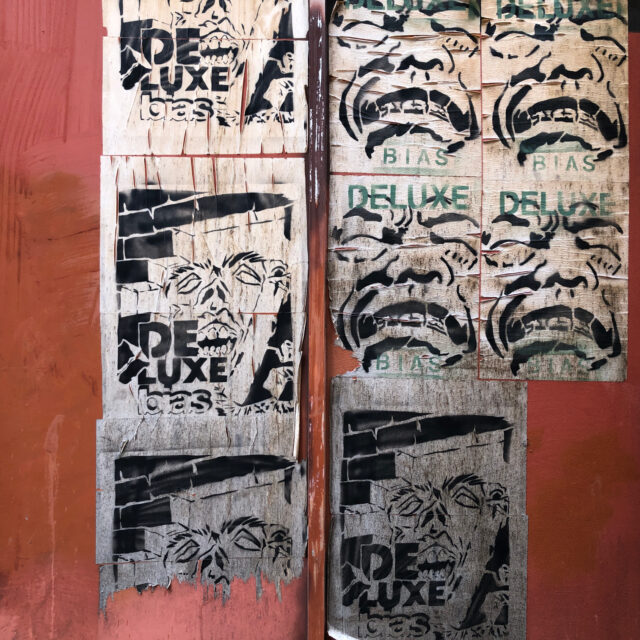
Something noticeable and enjoyable about New Britain is that it is not over-saturated with murals. Maybe that’s because the buildings overall have more attractive façades than elsewhere. Maybe they didn’t dive onto that bandwagon.
It’s a city that understands its scale.
Another place we see this: the resistance to other strains of sprawl. The hospital hasn’t completely taken over neighborhoods the way we see Hartford Hospital/Connecticut Children’s doing in Hartford. CCSU hasn’t totally leaked out of its footprint; you don’t see CCSU making huge strains on resources the way that, for instance, UConn does, demanding water from another town after it repeatedly has chosen to overbuild and over-enroll.
It feels more responsible than some communities in how it has decided to be.
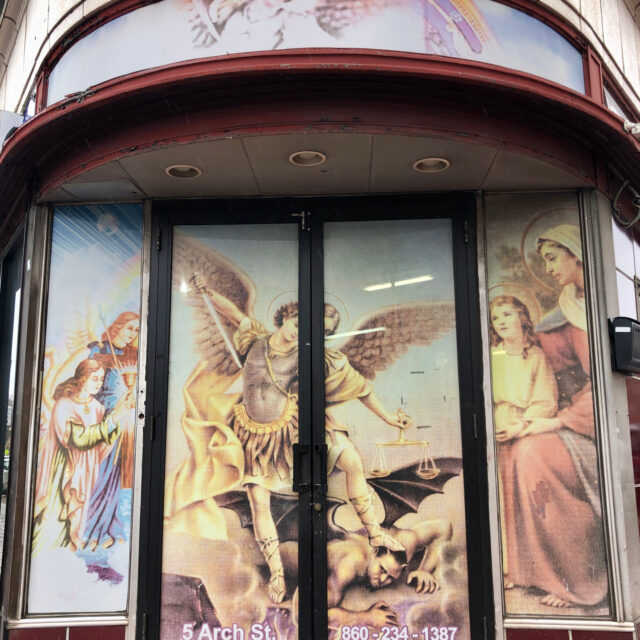
There are opportunities to learn about its history at the New Britain Industrial Museum, which opened in 1995 after talk of such a museum began in the late 1970s. It was previously on the Main Street side of Central Park, and now is on West Main Street separated from City Hall by one apartment building. They smartly chose to situate themselves in a building that existed before they did, resisting the lure of a shiny, brand new facility with which comes debt.
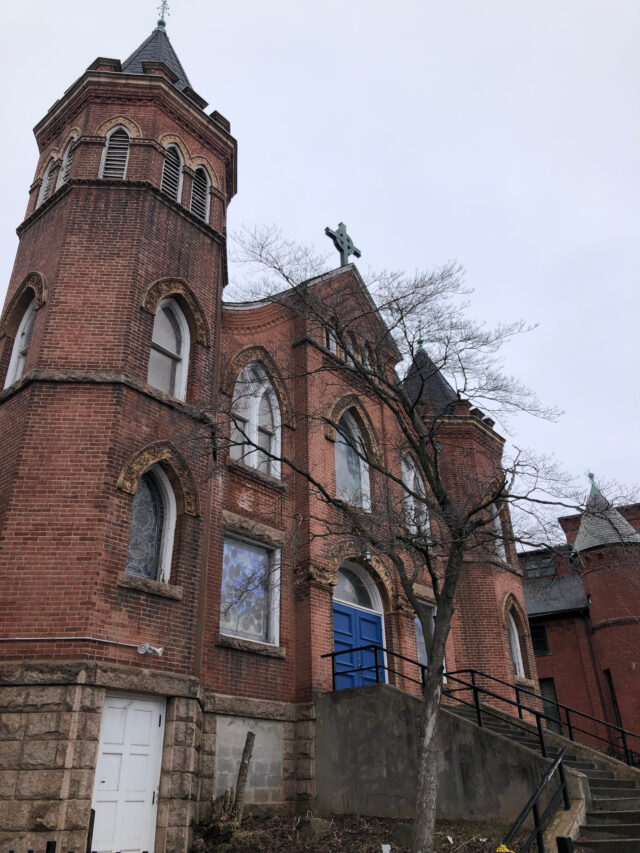
You can do some learning about the city’s history without going inside a building. Interpretative signs can be found along three self-guided walking tour loops
Often when we learn the history of a place, we hear the tellers use a detached, passive voice; the euphemisms and emotional distance flow, whether we are talking about Hartford or Willimantic or New Britain. It’s the language of “something happened that sent stores and populations elsewhere,” and it is a falseness to be wary of. Humans chose to build monster highways through cities, humans chose to build enormous shopping centers on cheap land at town borderlands squeezing out the established shops in downtowns, and humans chose to close factories.
And, what New Britain teaches, is that humans can choose to undo these harms, piece-by-piece.
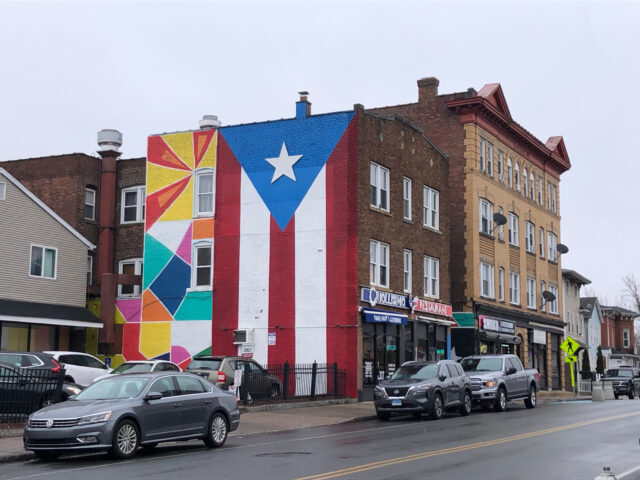
A place can choose to reinvest in its neighborhoods, in its downtown. Near City Hall, there’s now The Assembly Room, a food hall that is at a scale that makes sense in New Britain.
There are currently five vendors — one coffee/bakery kiosk, and then four others selling Salvadoran, Mexican, Tex-Mex cuisine, plus one focused on chickens.
The absence of music playing too loud for people to carry on a conversation was how I could tell this was not merely a Parkville Market replica. Maybe that happens later in the day.
That, and they have a cozy seating area with a fireplace.
In The Assembly Room window you can see a reflection of Central Park, which may have been a matter of concern to The Hartford Courant in 1887 but looked delightful each time I passed in recent years:
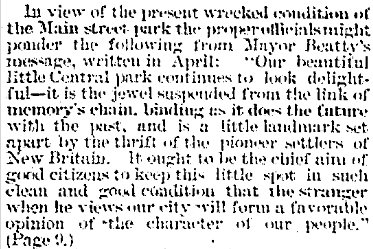
It was also as clean when I lived there, known from sharing meals in that location through Food Not Bombs. The park — what most might only view as a traffic island — is now easier to get to thanks to Complete Streets improvements.
What else?
At this point, it’s probably stranger for a town to not have a brewery than to have one.
New Britain has two.
There’s the one served by only one bus out by Newington, and then there’s Five Churches, benefiting from local bus service and within a ten-minute walk of the Downtown New Britain CTfastrak Station. I name these facts because it is exceptionally rare that an alcohol-serving establishment will take the initiative to promote more responsible ways for drinkers to travel. Why would you ever talk about your parking lot when you’ve got a sober designated driver nearby and at a rate much cheaper than Uber/Lyft?
For all the street improvements, it needs to be named that Route 555 (West Main Street) is not the greatest, and extra caution should be used if trying to cross it since no traffic calming efforts have yet been made on it.
The “yet” is my commentary and hope, and should not indicate that there is anything in the works.
Last year a police officer killed a pedestrian who was crossing West Main near the art museum — it was night, there’s a dip in the road, the street is designed such that the cop was able to drive double the posted speed limit, and the painted crosswalks nearby are just that, without walk signals or RRFBs. What’s hopeful is that New Britain is not a stranger to using paint and flex posts, as evident from walking down nearby Arch Street.
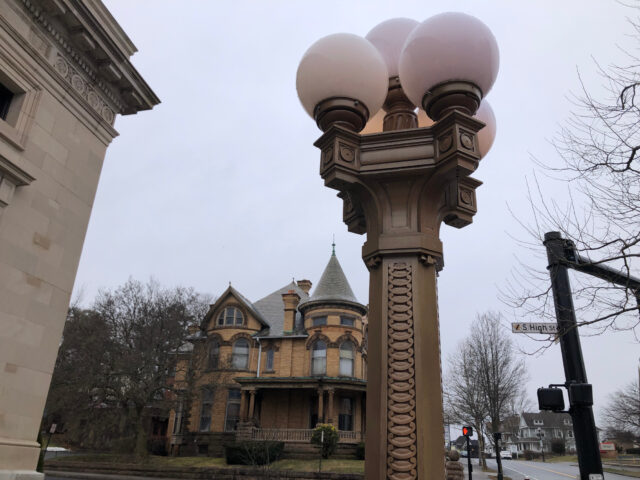
With a museum pass from the library, I was able to visit the New Britain Museum of American Art at no cost — something I try to do a few times each year. There was one particular exhibit that drew me in on the recent visit, but as usually happens, I found others to be more interesting than expected.
For whatever reason, people have been a little overzealous with their International Women’s Day/Women’s Month reveling, and I’ve grown weary of things that even remotely seem like they might get rah-rah about gender. I wasn’t planning to go through the “Women Reframe American Landscape” exhibit because all of that. But then, in the overwhelm of a busy art museum, I took a wrong turn and found myself in the exhibit, which I would have framed in other terms — though that would’ve been more radical, and maybe to get people to look, there’s reason to ensconce this in something that feels like “you go, girl!”
It’s an exhibit that ends up bringing a lot of conflicting feelings forward, as art sometimes should. I enjoy the Hudson River School style, a lot. I can do without most of whatever conceptual, abstract art fills galleries, but will revisit the beautiful landscapes again and again. I also, without shame, read romance novels. If you enter into either of these genres honestly, you know that you are not there for realism, and you are not there to stay. There are remnants of three-dimensional reality, but usually the messy, inconvenient pieces have been extracted. In the romance you are getting the most perfect moment expanded well beyond the moment, and that’s part of what turns it to fantasy. Readers who want either pure reality reflected or misery magnified on the page do not like romances.
The Hudson River School artists were — brace yourself for this shocker — mostly White men. And like many painters and photographers then and now, they did not simply document a place. They determined what to include and what to omit. The artwork was shaped by their perspective, experience, and privilege. The exhibit at NBMAA explores this, and that, not an artist’s gender specifically, is what makes for a fascinating array of art.
Seeing Jaune Quick-to-See Smith‘s “Stolen Map” on the wall made me happy for my wrong turn. I had learned of this 2021 beaded artwork last year when I had just missed a chance to see it elsewhere, and I guessed correctly that the photo of it on newsprint was not doing her creations justice. This is part of her map set/series and while you can get a better sense of it here than in a newspaper, it’s still better to go view it for yourself in person.
On a nearby wall is a larger piece by Ebony G. Patterson: “…the wailing . . . ushers us home . . . and there is bellying on the land.” This also is from 2021 with beads, and deals with the theme of stolen land.
Introducing more vantage points should always be welcomed, not because any of the different ones are necessarily more correct; it is to avoid the single story.
(Pardon the low-quality photo of artwork . . . it’s here to give sense of scale. Go view it in person.)
When not asking questions about who has a right to the land, there are those asking about how it is used.
Jean Shin‘s “Displaced” is a group of shipping crates containing material waste. Attention is given to shape, color, and those other elements of art, giving nobody a legitimate way to complain that this isn’t art.
Another wall in this exhibit is covered in Tanya Marcuse‘s “Woven No. 33”, a photograph of a diorama.
It feels right at home in a museum that has displayed Walter Wick’s work.
By the end of the exhibit is the Ecotopian Library, a hands-on “public toolkit that stems from the belief that art and ecotopian thought can be part of cultivating systemic social change.” (If you can’t make it down to the museum in time, explore the Ecotopian Library website to see some of the books and add to your TBR list)
The “Women Reframe American Landscape” exhibit wraps up on March 31, 2024. Clock is ticking.
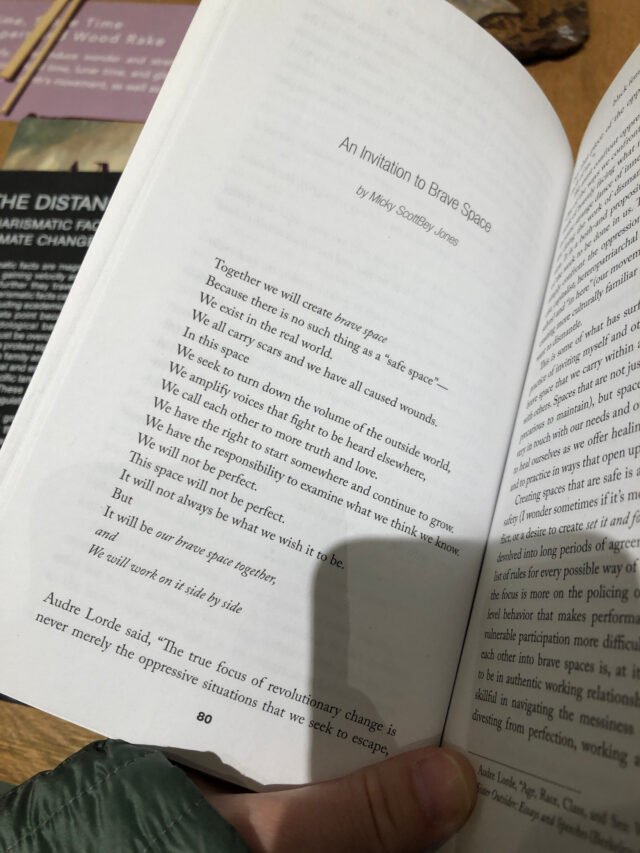
What I came here for, though, was exactly one thing: “Intersections” by Anila Quayyum Agha in the NEW/NOW room.
It was the first immersive piece with light that appealed to me at all, in part because it seemed so different from what else has been popular that I did not even think of them as being in the same artistic family.
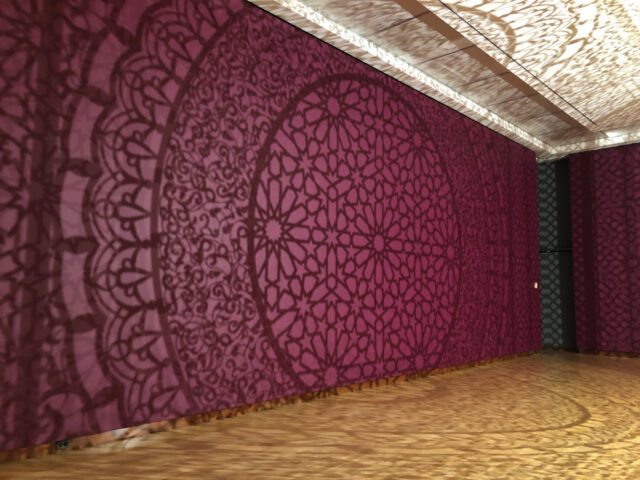
This is part of her NEW/NOW “Illuminations” exhibit, which is viewable through April 29, 2024.
Not every single exhibit is ending soon. Justin Favela‘s “Do You See What I See?” opened at the beginning of this month and will be up until December 1, 2024. It’s basically a synesthetic experience, at least for me, because I know what sound the material would be making when ruffled or smacked with a bat. It’s hard to walk through without touching the walls.
Anyway, the New Britain Museum of American Art exists, it’s awesome, they are with it enough to include public transit directions on their website — go visit them!
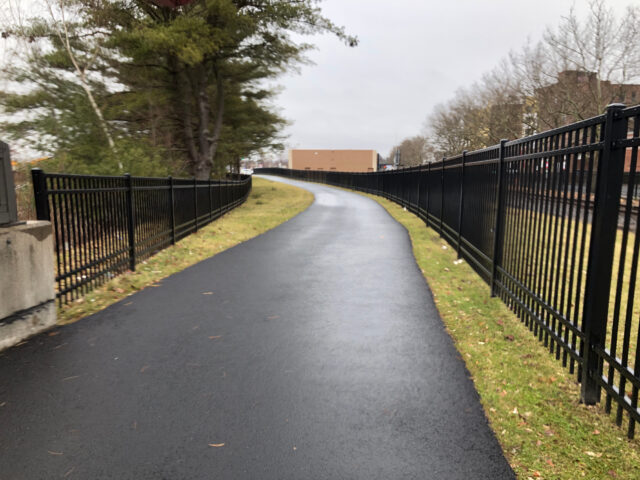
The museum is next to Walnut Hill Park, and it’s fine in the way that Hartford’s Bushnell Park is fine; wandering down New Britain’s streets feels more engaging, to me. The photo above is of the Beeline Trail, a work in progress.
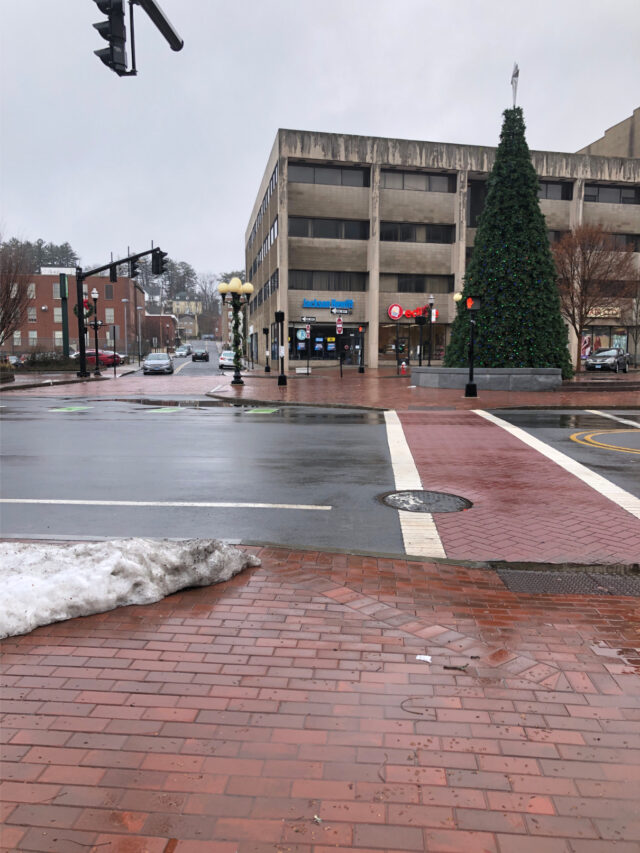
More than the current site for Central Connecticut State University, more than the former home of the New Britain Rock Cats, this city is seriously underrated and underestimated.
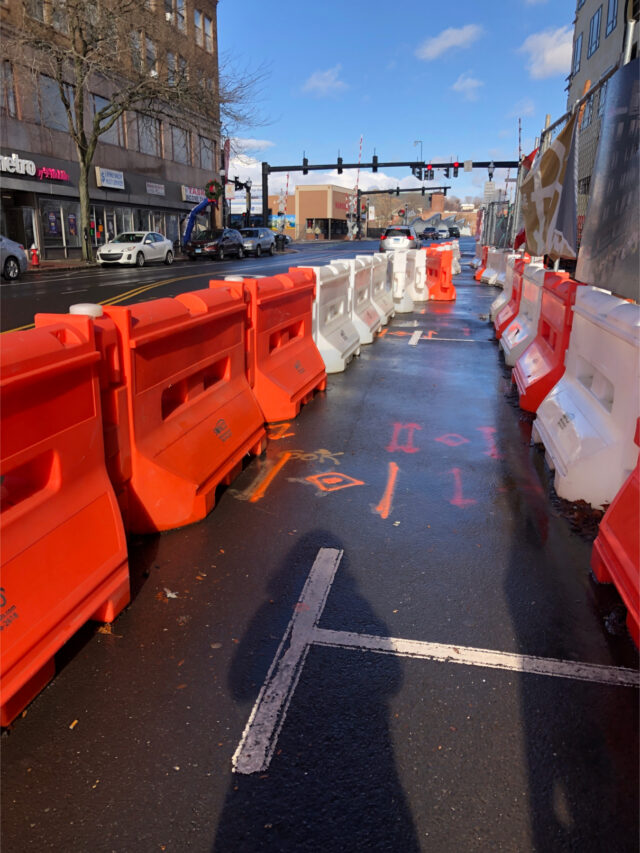
They’ve figured out uncomplicated concepts that neighboring towns can’t seem to grasp, like transit-oriented development and maintaining safe walkways for pedestrians during construction projects. You can’t blame/thank liberals for these bike lanes and other livability improvements — Mayor Erin Stewart is a Republican.
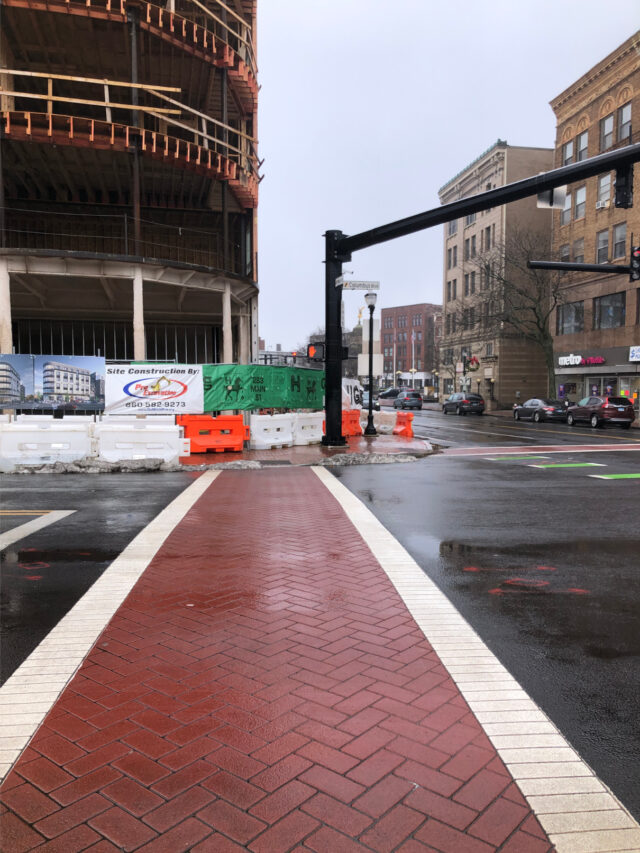
On both of the recent visits I made to New Britain, the weather was not in my favor (except for the two minutes the sun came out when I was on the Beehive Bridge), yet it still felt like a place that was comfortable to be. I could stand there taking photos of the painted street and not feel like the neighborhood’s Next Door was blowing up with speculation about what I was doing daring to stop and having a look around. I say this because there are many places in Connecticut where the place may look conventionally beautiful while feeling unwelcoming, if not hostile.
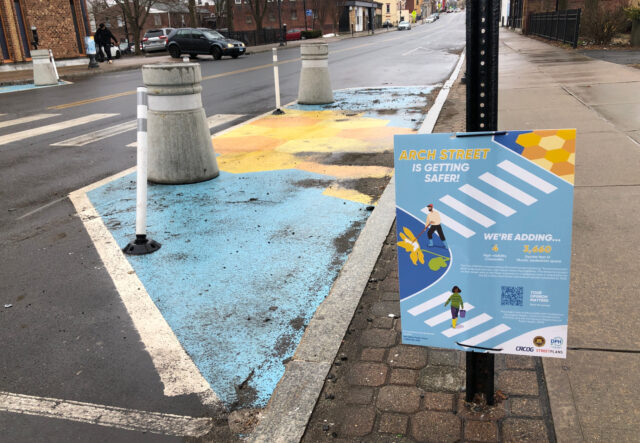
Good for New Britain for getting it together in a few really important ways, for having multiple restaurants and cafes in its downtown, for supporting multiple breweries, a speakeasy, a classy dining hall. All of which is to say that they have a million times more going on now than when I lived there, and I’m loving this journey for them.
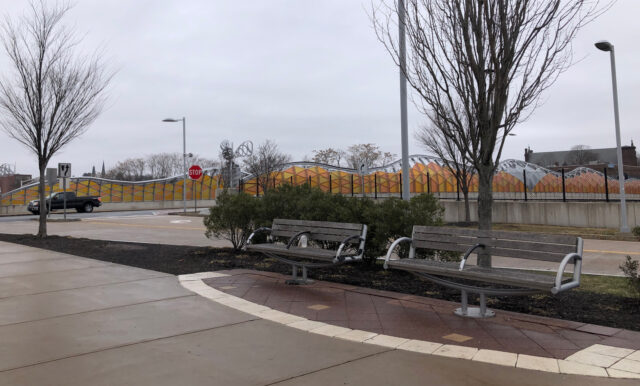
GETTING THERE: You can take multiple bus routes from Hartford to downtown New Britain. The 41 route will get you there eventually; the 101 and 102 CTfastrak buses will get you there faster. Another option: put your bike on one of the buses that use the busway and then get off at Newington Junction and ride the multi-use path the rest of the way; another other option is to do that but from one of the stations closer to downtown if you don’t want to ride/walk that far. An all-day local bus pass is $3.50.
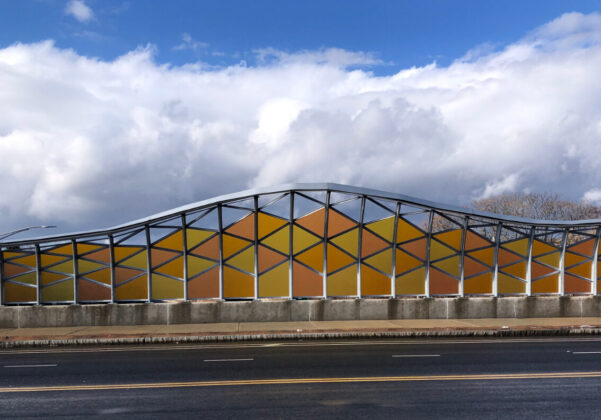
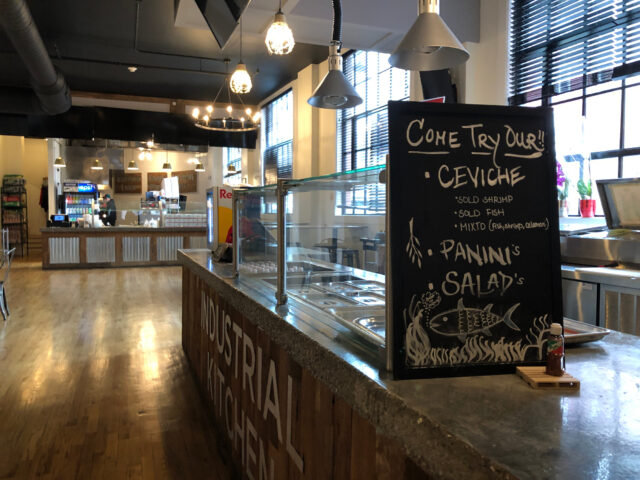
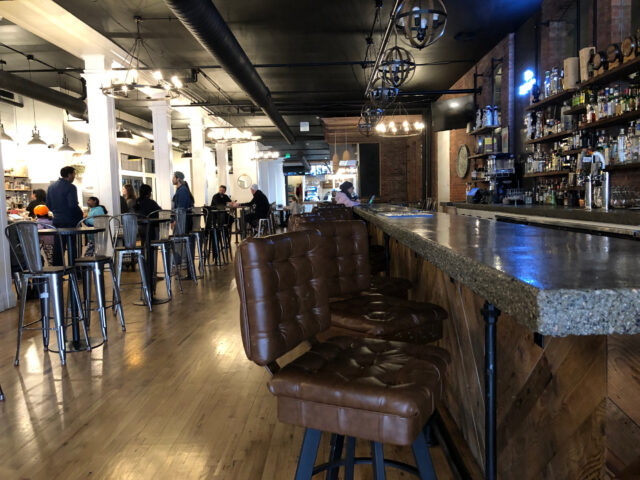
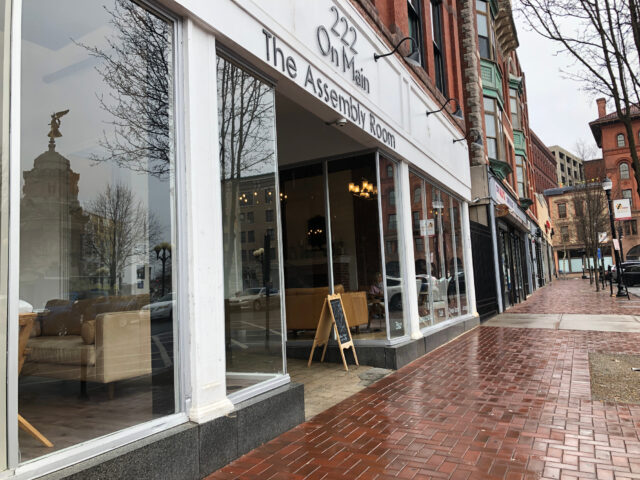
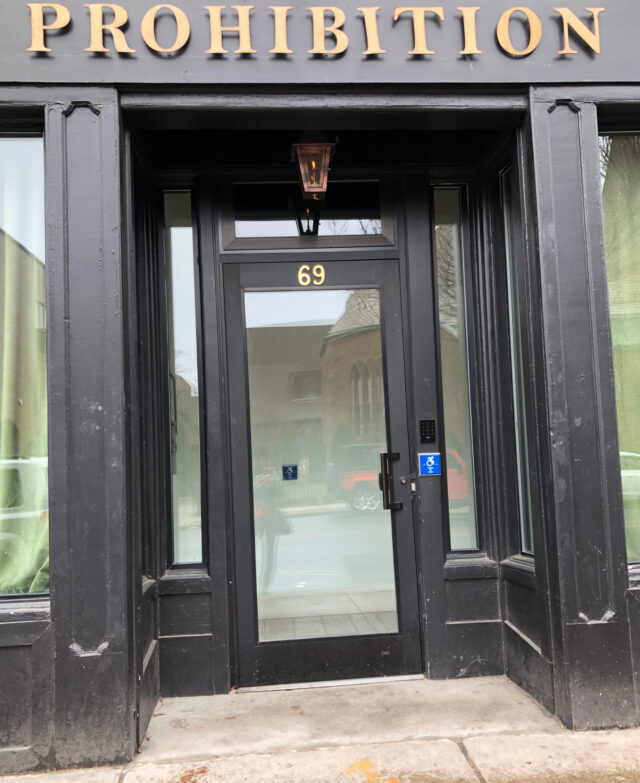
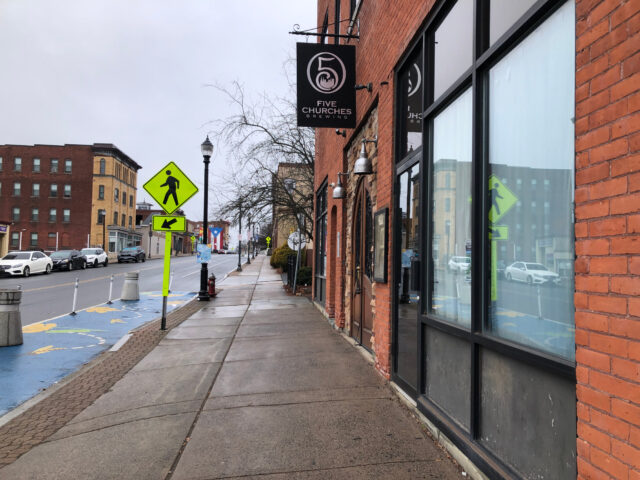
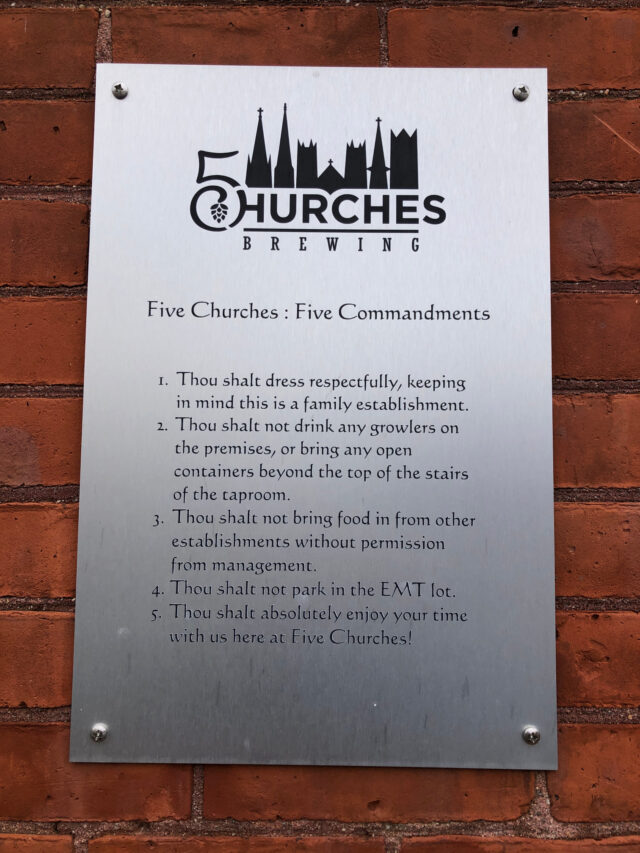

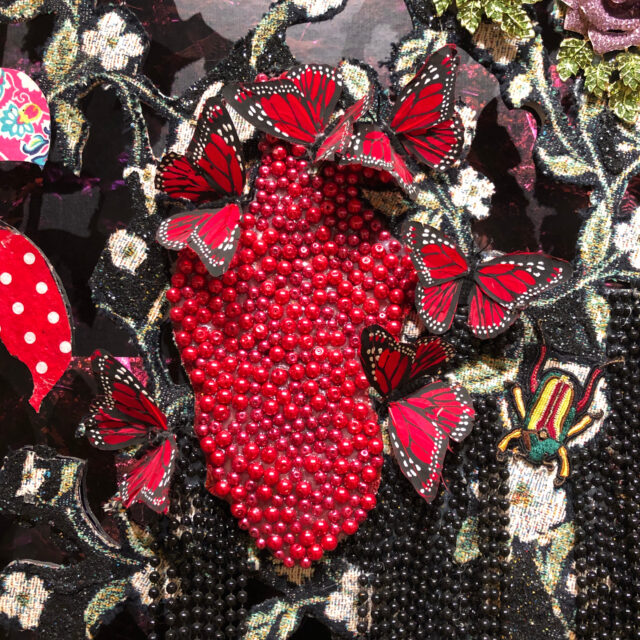
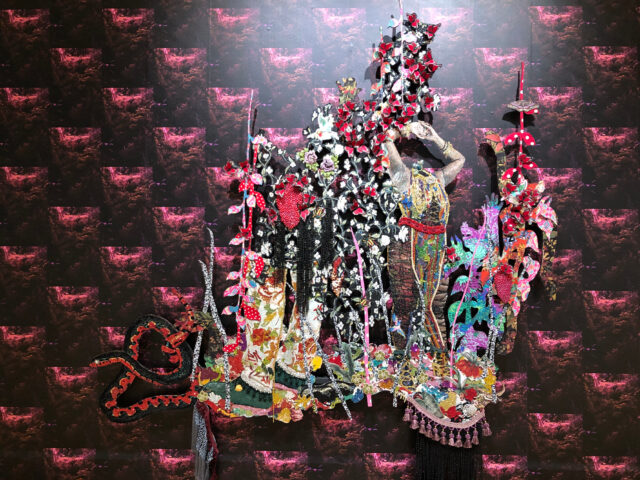
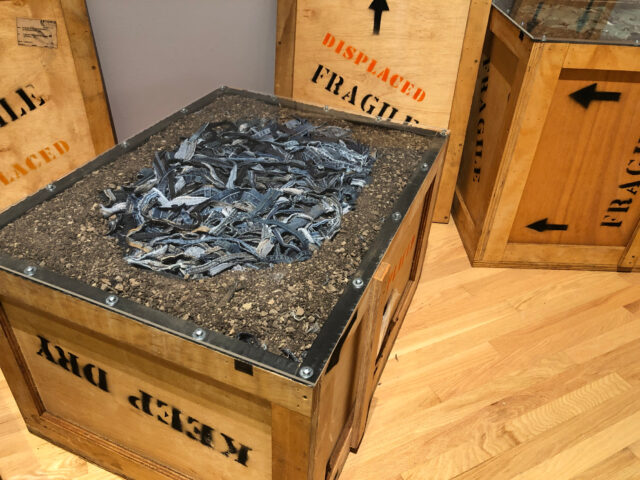
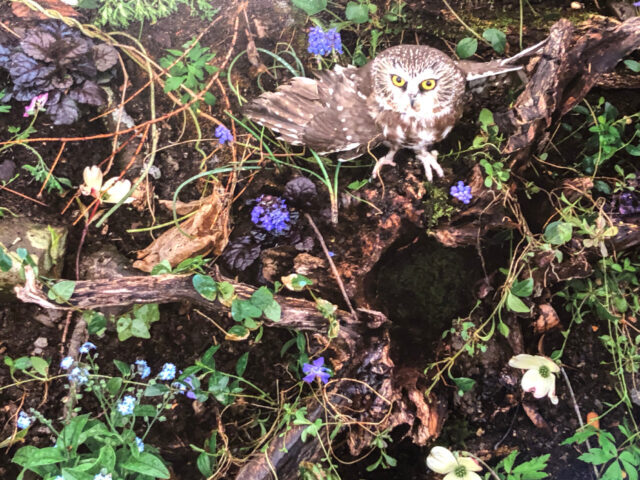
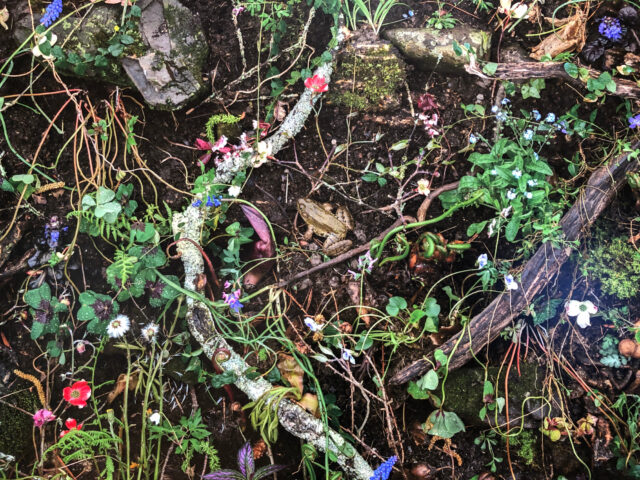
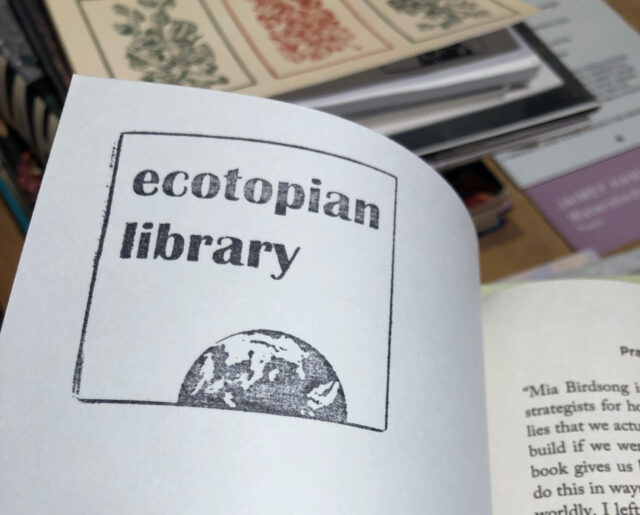
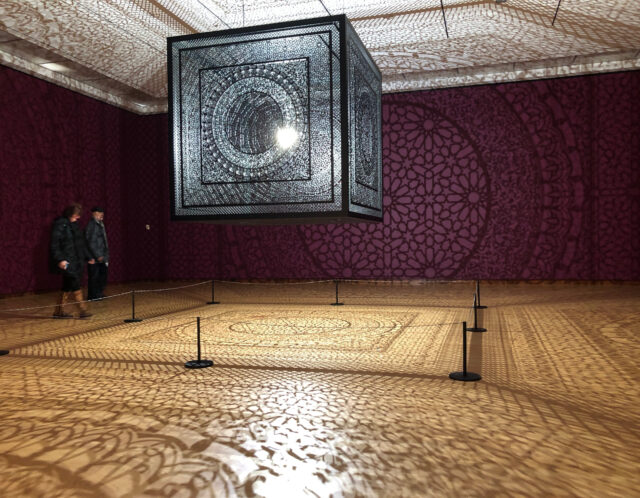
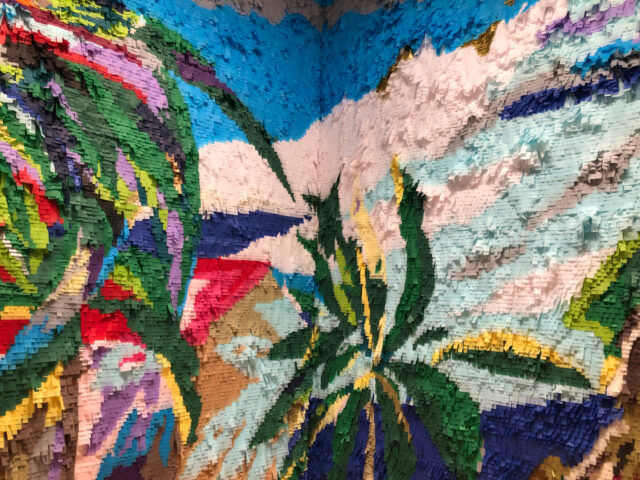
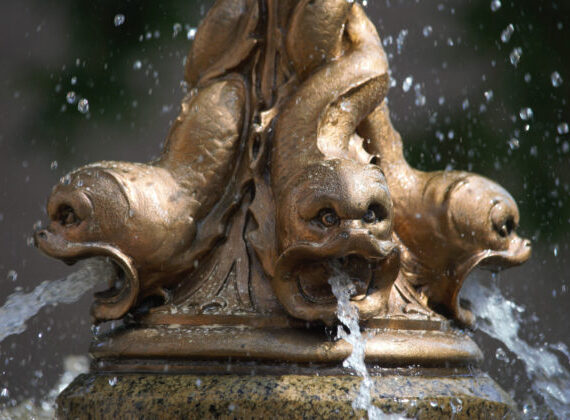
Sarah Roy
Beautiful, KAP! This piece makes me want to skip work and head up to NB right now. Sharing this far and wide. Thank you for all that you do.
Kerri Ana Provost
Today is a perfect weather day to do exactly that! Fully endorse!
Shirley Bloethe
It is really a great place to live and enjoy
Natalie Campbell
I am a 77 year old Baby Boomer who has lived in New Britain my entire life. Mayor Stewart has been able to fashion a city worthy of praise. She is bipartisan and has a vision that suits me just fine.☺️
R martin
Even though I left CT in 1997, I have been following all the great changes Mayor Stewart and the people of New Britain have made to the wonderful city. I grew up in this City and was said to see it deplete in the late 70’s.
I am moving back to CT this year, because I miss my Sons and their wives and my Grandchildren, my friends, the 4 seasons, and all the wonderful restaurants and many more. There have been many great people from Ct. we should all be proud. Great job for putting this city back together